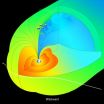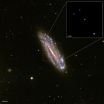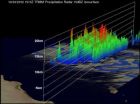(Press-News.org) A new study based on data from European Space Agency's Cluster mission shows that it is easier for the solar wind to penetrate Earth's magnetic environment, the magnetosphere, than had previously been thought. Scientists from NASA's Goddard Space Flight Center in Greenbelt, Md. have, for the first time, directly observed the presence of certain waves in the solar wind—called Kelvin-Helmholtz waves that can help transfer energy into near-Earth space—under circumstances when previous theories predicted they were not expected.
The recent paper, published on Aug 29, 2012, in the Journal of Geophysical Research shows that the presence of these waves help the incoming charged particles of the solar wind breach the magnetopause—the outer region of the magnetic "shield" around our planet. As a result, the boundary of Earth's magnetic bubble behaves less like a continuous barrier and more like a sieve allowing entry to the continuous onslaught of energetic electrons and protons.
"The complex environment near Earth varies continuously, but it is always filled with strong and complex magnetic fields. Variations in the pressure of the solar wind and in the orientation of the magnetic field can lead to changes in how the magnetosphere responds to the solar wind," says Melvyn Goldstein, a geospace scientist at Goddard and an author on the paper. "And understanding how the solar wind impacts these changes by transferring material, momentum and energy across the magnetopause, is one of the most important questions in magnetospheric physics in general and space weather effects in particular."
This latest discovery was made possible by the unique configuration of the four identical Cluster spacecraft, which fly in a closely controlled formation through near-Earth space. As they sweep from the magnetosphere into interplanetary space and back again, the flotilla provides unique three-dimensional insights on the processes that connect the sun to Earth.
Previous discoveries derived from Cluster measurements have shown that the magnetopause is commonly subject to Kelvin-Helmholtz waves. These waves have a distinctive shape that is quite familiar: they look like large amplitude ocean waves that are whipped up by strong winds. Such waves generate turbulence as they crest and break. In the case of the solar wind, the waves are made of huge swirls of electrified gas called plasma, up to 25,000 miles across, which develop along the outer edge of the magnetosphere. Moving plasma, and therefore the Kelvin-Helmholtz waves, trap magnetic fields along with them, which turn out to be crucial in trying to determine how the solar wind can enter the magnetosphere. As the magnetic field becomes wrapped up in the Kelvin-Helmholtz waves, oppositely directed fields can "reconnect", allowing plasma to move from the solar wind into the magnetosphere.
"The space weather community pays considerable attention to Kelvin-Helmholtz waves," says Kyoung-Joo Hwang, a research scientist at Goddard and the University of Maryland Baltimore County and lead author of the paper. "Because they have global influence on Earth's magnetic system and are important for understanding Earth's response to changes on the sun."
In general, the solar wind's ability to penetrate into near-Earth space is thought to rely on the magnetic alignment of the interplanetary magnetic fields, often shortened to IMF. As the solar wind streams from the sun toward the day side of Earth, its magnetic fields connect up to those of Earth, resulting in a sudden and dramatic reconfiguration or reconnection of the field lines. This is most efficient when the IMF is aligned southward – opposite to the northward alignment of Earth's magnetic field. The temporary tangling of the field lines creates ideal conditions for magnetic reconnection, allowing large amounts of plasma and magnetic energy to be transferred from the solar wind to the magnetosphere.
Magnetic reconnection also occurs more weakly with a northward orientation of the IMF, generally only seen at higher latitudes. Spacecraft observations have indicated that Kelvin-Helmholtz waves may play an important role in the transfer of solar wind material into the magnetosphere during a northward IMF – a hypothesis bolstered by the fact that the waves can facilitate magnetic reconnection. However, previous identification of Kelvin-Helmholtz waves during northward IMF were limited to the low latitude flanks of the magnetosphere.
The team of scientists has now directly observed these Kelvin-Helmholtz waves at high latitudes under other orientations of the IMF. Instead of pointing north or south, the IMF was pointing west, towards the dawn side of Earth. Under these conditions, the Cluster data showed the waves on the dusk side of the high-latitude magnetopause. The magnetopause is the boundary between the relatively undisturbed magnetosphere and the magnetosheath, the region containing solar wind plasma that has come across the bow shock that protects Earth from the direct onslaught of solar wind plasma. The scientists were also able to characterize how differences in IMF orientation greatly influenced the Kelvin-Helmholtz waves as a result of variations in the thickness and other characteristics of the boundary layer.
The data were obtained between 7:00 a.m. and noon EST on 12 Jan., 2003. The four Cluster spacecraft were in tetrahedral formation, about 2,500 miles apart, flying close to the northern duskward region of Earth's magnetosphere. The quartet was outbound, heading toward the evening side magnetopause.
"This was the first time that the presence of Kelvin-Helmholtz waves at the magnetopause had been demonstrated at high latitude for a dawnward orientation of the IMF," said Hwang. "We are seeing these waves in unpredictable places, under solar wind conditions that were previously thought to be unfavorable for their generation."
While the paper reports on only one case study, similar conditions are frequently found in the magnetosphere, says Goldstein. "Since this and similar geometrical orientations of the IMF are common, the process we describe might act as a fairly continuous mechanism of solar wind transport into the magnetosphere."
Hwang is now undertaking a statistical study to determine how ubiquitous the Kelvin-Helmholtz waves are and how they evolve and develop.
"This discovery shows how Earth's magnetosphere can be penetrated by solar particles under certain interplanetary magnetic field conditions," said Matt Taylor, ESA project scientist for Cluster. "The study of the high-latitude, dayside magnetopause would not have been possible without the in-situ measurements sent back by Cluster. The relatively small spatial separation of the four spacecraft made it possible to analyze the spatial structures and characteristics of the Kelvin-Helmholtz waves."
These results are also relevant to studies of magnetospheric processes around other planets in the solar system. For example, Kelvin-Helmholtz instabilities are commonly observed at the boundary of Mercury's magnetosphere and on the dawnward flank of Saturn's magnetopause. This new study opens up the possible locations where such waves may be generated, suggesting that they can be a common, and possibly continuous, mechanism for the entry of solar wind into planetary magnetospheres under various IMF orientations.
INFORMATION:
NASA study using cluster reveals new insights into solar wind
2012-10-25
ELSE PRESS RELEASES FROM THIS DATE:
Galaxy halos are produced by orphan stars, findings indicate
2012-10-25
Irvine, Calif., Oct. 24, 2012 – Isolated stars kicked to the edges of space by violent galaxy mergers may be the cause of mysterious infrared light halos observed across the sky, according to UC Irvine and other astronomers.
"Background glow in our sky has been a huge unanswered question," said UCI physics & astronomy professor Asantha Cooray, lead author of a paper about the discovery in the Oct. 25 issue of the journal Nature. "We have new evidence that this light is from stars that linger between galaxies. Individually, they're too dim to be seen, but we think we're ...
Video game with biofeedback teaches children to curb their anger
2012-10-25
Boston, Mass. , Oct. 24, 2012—Children with serious anger problems can be helped by a simple video game that hones their ability to regulate their emotions, finds a pilot study at Boston Children's Hospital. Results were published online October 24 in the journal Adolescent Psychiatry.
Noticing that children with anger control problems are often uninterested in psychotherapy, but very eager to play video games, Jason Kahn, PhD, and Joseph Gonzalez-Heydrich, MD, at Boston Children's Hospital developed "RAGE Control" to motivate children to practice emotional control skills ...
NASA satellite shows the Tropical Storm Son-tinh's reach over Philippines
2012-10-25
The latest tropical storm in the western North Pacific Ocean has already spread its clouds and showers over the Philippines, as seen in NASA satellite imagery. NASA's Aqua satellite captured an image as it flew over Tropical Storm Son-tinh today, Oct. 24.
On Oct. 24, 2012 at 0445 UTC (12:45 a.m. EDT) the Moderate Resolution Imaging Spectroradiometer (MODIS) instrument that flies aboard NASA's Aqua satellite captured a visible image of Tropical Storm Son-tinh. At the time of the image, Son-tinh's center was moving through the central Philippines, but its cloud cover extended ...
Revealing a mini-supermassive black hole
2012-10-25
One of the lowest mass supermassive black holes ever observed in the middle of a galaxy has been identified, thanks to NASA's Chandra X-ray Observatory and several other observatories. The host galaxy is of a type not expected to harbor supermassive black holes, suggesting that this black hole, while related to its supermassive cousins, may have a different origin.
The black hole is located in the middle of the spiral galaxy NGC 4178, shown in this image from the Sloan Digital Sky Survey. The inset shows an X-ray source at the position of the black hole, in the center ...
NASA's TRMM satellite sees birth of Arabian Sea cyclone
2012-10-25
NASA's TRMM satellite measured rainfall and towering clouds within the Arabian Sea's first tropical cyclone of the season as it passed overhead from space. Meanwhile, the infrared AIRS instrument aboard NASA's Aqua satellite noticed that strong thunderstorms surrounded the center of the storm. Tropical Cyclone 1A is expected to be short-lived as it heads for a landfall in Somalia on Oct. 25.
Since it was launched in 1997 the Tropical Rainfall Measuring Mission (TRMM) satellite has been useful for monitoring tropical cyclones in the tropics. TRMM passed above the first ...
Moderate drinking decreases number of new brain cells
2012-10-25
Drinking a couple of glasses of wine each day has generally been considered a good way to promote cardiovascular and brain health. But a new Rutgers University study indicates that there is a fine line between moderate and binge drinking – a risky behavior that can decrease the making of adult brain cells by as much as 40 percent.
In a study posted online in the journal Neuroscience, scheduled to be published on November 8, lead author Megan Anderson, a graduate student working with Dr. Tracey J. Shors, Professor II in Behavioral and Systems Neuroscience in the Department ...
Study shows whites twice as likely as blacks to get CPR from bystanders
2012-10-25
AURORA, Colo. (Oct. 24, 2012) – In the first study of its kind, researchers have found that those who suffer cardiac arrests in upper income, white neighborhoods are nearly twice as likely to get cardiopulmonary resuscitation (CPR) than people who collapse in low-income, black neighborhoods.
"If you drop in a neighborhood that is 80 percent white with a median income over $40,000 a year, you have a 55 percent chance of getting CPR," said study author Comilla Sasson, MD, an emergency room physician at the University of Colorado Hospital. "If you drop in a poor, black neighborhood ...
Reclaiming rare earths
2012-10-25
Recycling keeps paper, plastics, and even jeans out of landfills. Could recycling rare-earth magnets do the same? Perhaps, if the recycling process can be improved.
Scientists at the U.S. Department of Energy's (DOE) Ames Laboratory are working to more effectively remove the neodymium, a rare earth element, from the mix of other materials in a magnet. Initial results show recycled materials maintain the properties that make rare-earth magnets useful.
The current rare earth recycling research builds on Ames Laboratory's decades of rare-earth processing experience. In ...
Sleep-deprived bees have difficulty relearning
2012-10-25
Everyone feels refreshed after a good night's sleep, but sleep does more than just rejuvenate, it can also consolidate memories. 'The rapid eye movement form of sleep and slow wave sleep are involved in cognitive forms of memory such as learning motor skills and consciously accessible memory', explains Randolf Menzel from the Freie Universtät Berlin, Germany. According to Menzel, the concept that something during sleep reactivates a memory for consolidation is a basic theory in sleep research. However, the human brain is far too complex to begin dissecting the intricate ...
Experts call for increased neonatal inclusion in pediatric drug trials
2012-10-25
Cincinnati, OH, October 25, 2012 -- Clinical drug trials are a vital part of pharmaceutical manufacturers gaining approval for use by the U.S. Food and Drug Administration. A Commentary scheduled for publication in The Journal of Pediatrics assesses the issues surrounding the lack of clinical trials on medications used by children, most notably neonates, and how drug manufacturers and academic researchers could work together to create clinical trials that would benefit this underrepresented population.
Henry Akinibi, MD, and colleagues from Cincinnati Children's Hospital ...




